2023 ITG Conference Report - Day 4 - Friday, June 2
The 47th Annual International Trumpet Guild Conference - Minneapolis, Minnesota (USA)
Special Daily Report • Compiled by Peter Wood
Photos by Steven Garcia, Benjamin Lowe, Josh Rzepka, and Michael Anderson
Friday, June 2, 2023
Click here for more photos from the ITG Conference
Non-Pro Players warm-up session - Christopher Moore
Friday morning saw a noteworthy start with Dr. Christopher Moore’s Non-Pro Players warm-up session. Beginning with the two solid rules of “don’t play loud” and “strive for ease,” Moore led the room through his preferred warmup, demonstrating how he approaches his “big six:” tone, technique, flexibility, articulation, range, and dynamics. Moore emphasized that each person should tailor a warmup for their specific needs and encouraged individuals to adjust each day as needed. Incorporating tone bending and glissandos between partials, the warmup focused on developing beauty in the sound and always playing with ease. He displayed finesse and refinement in his playing while also reminding all to not play loudly. He included modified Clarke studies, Irons flexibilities, Cichowicz flow studies, and more throughout the morning, concluding with extra time to answer individual questions. Christopher Moore’s session was highly beneficial for all. (Spencer Wallin)
Scott Belck youth warm-up session - The Flexibility Warm-Up Hack that THEY don’t want YOU to know about!
As a highly regarded performer, educator, and author, Scott Belck’s morning warm-up session featured exercises from his books Modern Lip Flexibilities and Progressive Lip Flexibilities, as well as slotting exercises. Belck stressed the importance of feeling when playing. With regard to warming up and practicing, Belck mentions that “The better your chops feel, the more you need to make sure you’re taking rest.” Belck stressed the importance of using a timer within a practice session to aid with endurance. His detailed approach to pedagogy, combined with the creativity of the lip slur patterns in his books culminate in an excellent pathway for students to develop more consistent flexibility and a stronger embouchure. (Madison Barton)
Warm-up session - Stanley Curtis: Being Creative with Your Warmup
Stanley Curtis, trumpet professor at Colorado State University, led a challenging and thorough warm-up class by incorporating variety and creativity into the daily routine. Guided by the idea of adaptive resistance, the overarching concept was to “keep the basics and change the material.” Curtis outlined different sources of inspiration for creative routines, including chorales/vocalises, jazz standards, scales/arpeggios, excerpts/etudes, free composition, and non-musical ideas such as art/poetry/dance. As an example, he built a warmup based around Gustav Mahler’s “Songs of a Wayfarer” with attention to embouchure stability, tone, continuity of air, finger technique, slurs, articulation, and change of registers and dynamics. The idea of using “real music” during the warmup was beneficial in that it can cover all aspects of trumpet playing and help the musician relate their fundamentals to a piece of music they may perform. Curtis’s innovative approach left attendees motivated and inspired. (Steven Siegel)
Youth Session - Jennifer Oliverio: Expanding Your Musicianship Dashboard
Jen Oliverio’s morning session focused on the importance of maintaining a sense of versatility within varying styles and approaches that we use in our respective performance mediums. Principal cornetist with the Fountain City Brass Band, Oliverio demonstrated use of fundamentals in a streamlined and accessible manner with both cornet and trumpet. Throughout, differences in tone color and vibrato were noted with similar passages. Examples of exercises focusing on tone quality, flexibilities, and range were all addressed as a means of creating a consistent and effective fundamental routine. Along with providing insight in creating an attainable routine, Oliverio touched on the realities of having strong and weak traits in one’s playing. Maintaining a sense of awareness of what works and what doesn’t is important as musicians continue to refine their craft in areas that may need continued focus. (Jeremy Perkins)
Manny Laureano masterclass - Applying Musical Rules to Orchestral Playing
The University of Dayton Trumpet Ensemble opened this event with a blazing fanfare followed by a splendid performance of the Vivaldi Concerto for Two Trumpets. Manny Laureano’s masterclass session began with a reminder of how important it is to be constantly listening to great artists. To emphasize this point, he referred to a statement in the back of the Arban book encouraging all to “seek out the most illustrious models.” Laureano briefly discussed his time as a student and how sometimes, as students, we aren’t ready for the information taught. He then described one of his most recent endeavors, a recording project entitled Section Orchestral Excerpts for Trumpet. Laureano encouraged all seeking a career in an orchestra to abide by certain rules in music and to make sure one has command of their instrument, especially when it comes to intonation. He then played some examples from this resource while sharing insightful suggestions and inspiring stories from throughout his magnificent career. (Richard Tirk)
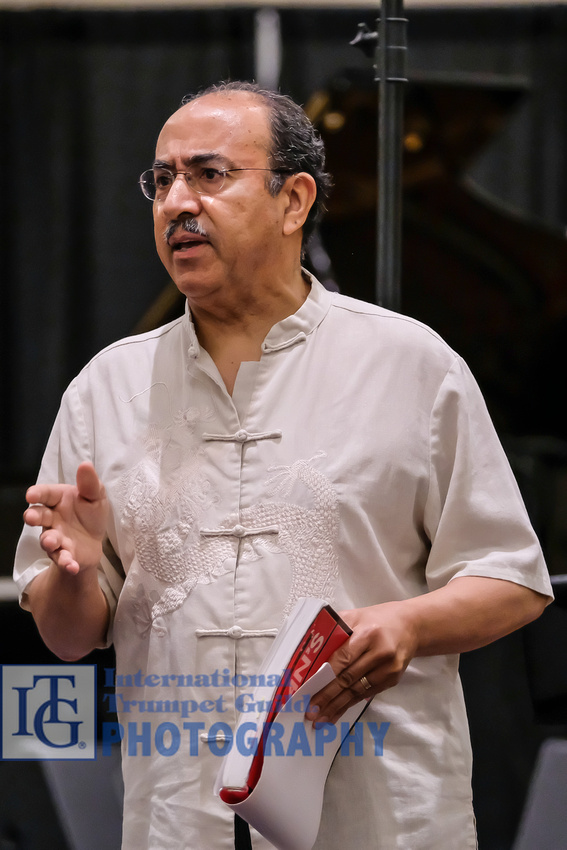

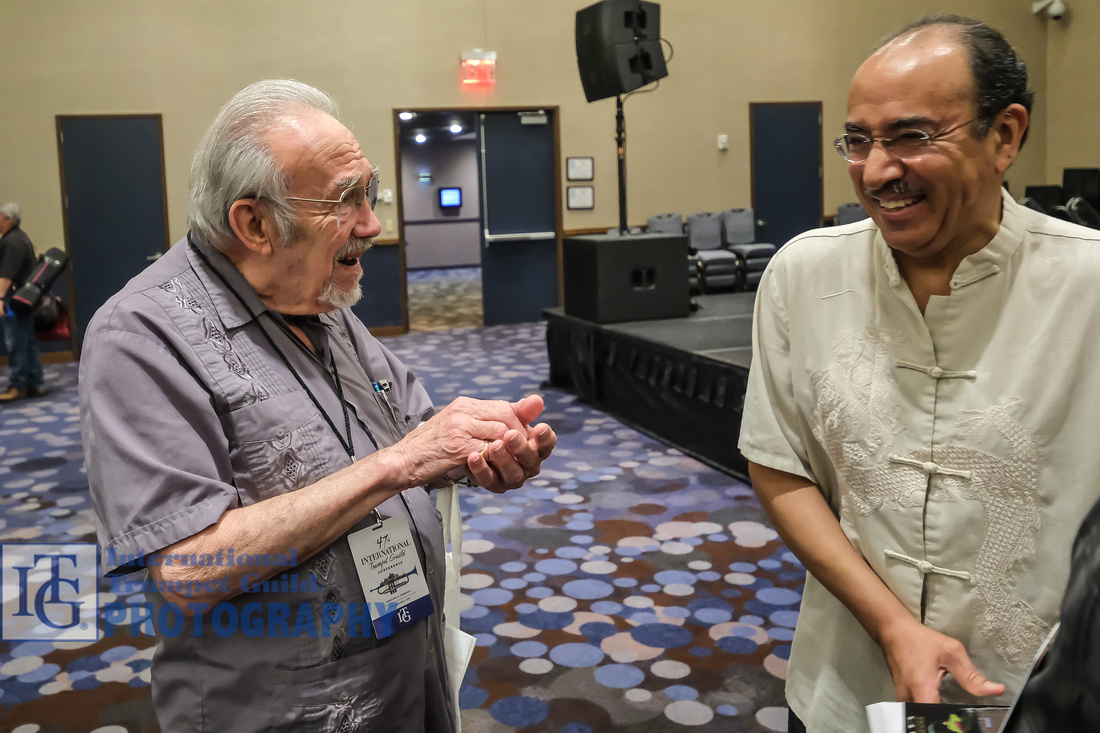

David Pastor session - The Three Fundamental Pillars of Trumpet Study
David Pastor’s presentation was both insightful and enlightening. He highlighted these pillars as crucial aspects on which every trumpet player should focus to enhance their skills. The first pillar is the importance of positioning the sound with ease. Pastor emphasized the significance of finding the right embouchure and mouthpiece placement to produce a clear and resonant sound. The second pillar, flexibility, highlights the need to develop the ability to navigate smoothly through various registers and articulations. Lastly, Pastor stressed the significance of finger mobility in all registers. By working on finger dexterity, trumpet players can enhance their technical abilities and achieve greater precision in executing fast and intricate passages. Overall, David Pastor’s presentation was highly enlightening and shed light on these key areas of focus for trumpet players aspiring to excel in their craft. (Javian Brabham)
John Cord session - College Studio Recruiting 101: How To Effectively Recruit the Modern High School Trumpeter
After Eastlake High School Trumpet Ensemble’s energetic prelude performance of Dos Tiempos, Dr. John Cord launched into a thorough presentation of his strategies for recruiting for his college studio. Starting with an overview of building studio visibility, Cord discussed effective methods for branding and developing digital and print marketing materials. He detailed ways to utilize a variety of social media and web-based platforms to disseminate a studio’s brand. He shared several of his promotional videos and discussed strategies for creating engaging media. Beyond digital recruiting, Cord addressed in-person strategies such as recruiting and performance tours and inviting prospective students to perform or participate in side-by-side experiences with current students, including hosting on-campus events. He also discussed methods for gathering contact information and communicating with prospective students and their parents. He even discussed places to find funding for recruiting initiatives. Cord’s presentation was a valuable guide to expanding and improving recruiting tactics for any applied faculty member. (Eric Millard)
Ryan Anthony Memorial Trumpet Competition: Solo Performance Division Finals
The final round of the Solo Performance Competition was a superb addition to the events on Friday morning. The three finalists, Matthew Brotherton, Grace O’Connell, and Jade Park each performed extremely well, demonstrating great musicianship and talent. The panel of judges consisted of Cynda Fleming, David Hickman, and Manny Loureano, and the finalists were introduced by the solo competition division chair, André Bonnici. Each contestant was required to perform the fourth movement (“Whale/Thunderbird”) of Catherine McMichael’s Totem Voices, as well as one of three unaccompanied pieces and a selection of their choice. Brotherton performed first and played with clean musical maturity. He had a strong beginning, contrasted with sweet, lyrical melodies throughout. He played the first movement of the Tamberg Concerto, in which he navigated the incredible technical challenges with ease and showed a clear understanding of the music. Grace O’Connell performed next and played the second and third movement of the Planel Trumpet Concerto for her selected piece. She played with a rich, full sound, displaying excellent lyrical playing with compelling musical expression, and ended with playful and articulate technique that was intertwined with beautiful melodies. Jade Park was the last to perform and played all of her music from memory. She had a lovely sound that filled the room at times and made difficult passages sound easy. She performed the Arutiunian Trumpet Concerto for her selected work, and her fast and exciting tempo was a good contrast to the graceful lyrical sections. The audience thoroughly enjoyed the solo performance finals. (Spencer Wallin)
Oscar Fernando Trujillo Gómez recital - A Musical Journey through the Country of 1000 Rhythms
The Royal Irish Academy of Music Trumpet Ensemble opened the recital with terrific performances of Vassily Brandt’s Country Picture and Nos. 1 and 4 from Anton Diabelli’s Twelve Stücke. Oscar Fernando Trujillo Gómez proceeded to dazzle the audience with his sensational tone and musicality on a program of Colombian music, highlighting some of the nation’s 1000-plus traditional folk rhythms. The program featured a variety of repertoire, including several of Gómez’s own compositions (Suite pa’Juan, Concierto for Trumpet, Tres Aires del Pacifico, and Bambuco Fandanduiao). Other works on the program included Rubén Dario Gómez Prada’s Concertino for Trumpet, Ferney Lucero Calvachi’s Yolanda, and El Duende and Batero by Daniel Alberto Moreno Vergara. Gómez paused to describe the tradition and use of the folk rhythms incorporated into each work, helping the audience immerse themselves into Colombian culture. Gómez’s brilliant playing captivated the audience, beautifully highlighting Colombia’s rich musical traditions. (Eric Millard)
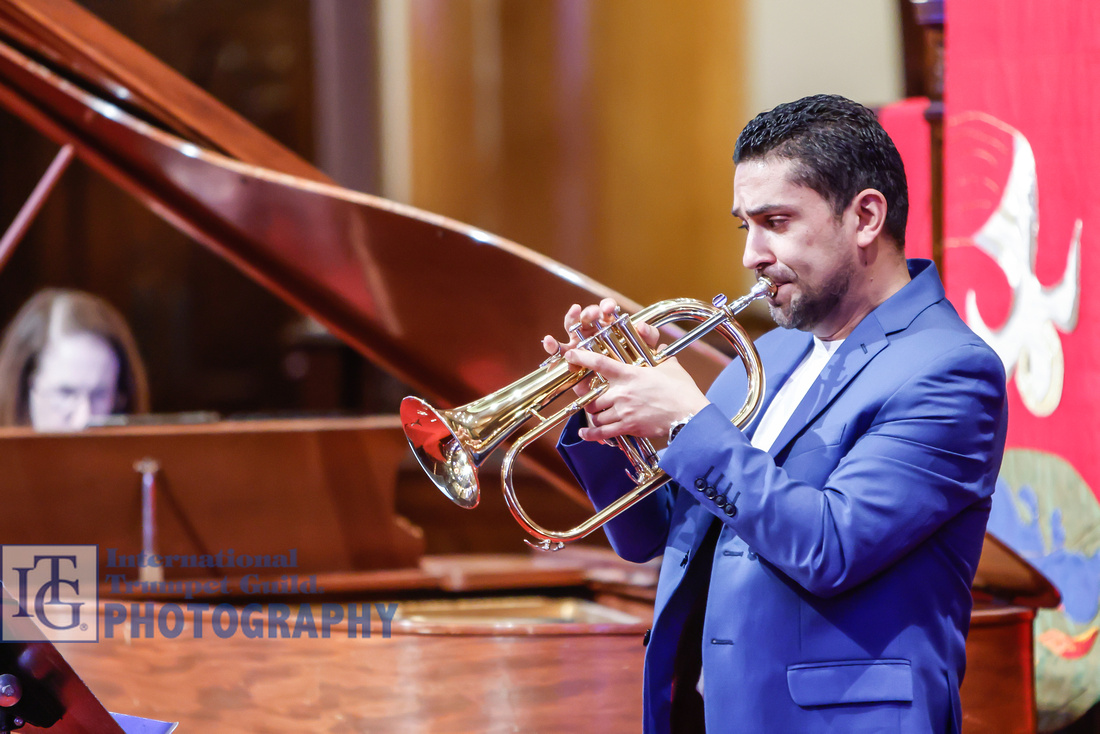

Youth Session - Matilda Lloyd: How to Perform the Best Solo of Your Life
In Matilda Lloyd’s educational presentation, she offered three main ideas to help enhance a player’s ability to perform solos. Her first and main concept was to be confident. She offered strategies to help with confidence, including using affirmations, performing a superhero pose prior to the performance, and walking onto stage with strong posture and pressure. She followed with a breakdown of her approach to involved music preparation and the method she uses to encourage confidence. Based upon symptoms she has personally handled, she then offered strategies to counteract performance anxiety. Examples included dressing comfortably, running or jumping prior to the performance to expel excess energy, and seeking more performance opportunities. Matilda recommends sticking to your strategies once you find what works for you and to make them a part of your performance-day routine. She concluded her presentation with a Q&A session. (Kyle McLean)
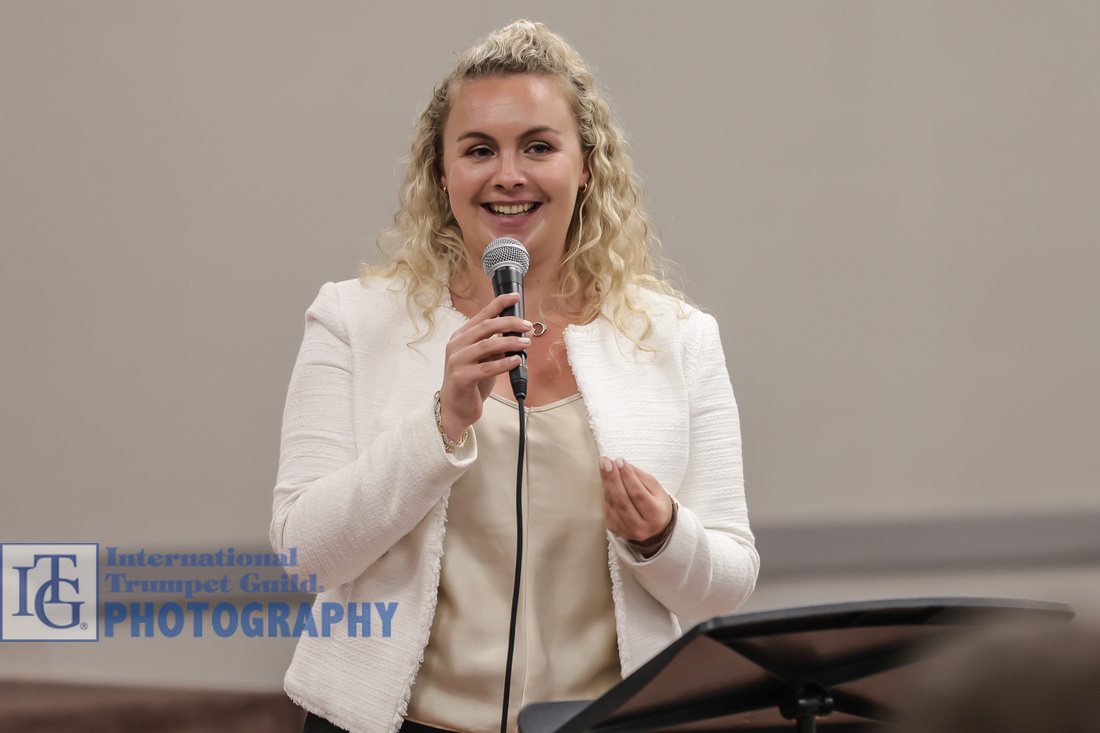

Axiom Brass lecture recital - Reexamining the Brass Quintet Experience through Diverse Programming and Interdisciplinary Collaborations
The lecture recital given by the Axiom Brass focused on reexamining and redefining the brass quintet repertoire through diverse and interdisciplinary programming initiatives. The group focused the session on madrigals written by women and other underrepresented populations, highlighting works that have never before been transcribed for the brass quintet medium. Axiom’s current album project, “Limitless,” intends to feature works from this genre and hopes to normalize their use in performance settings such as weddings, funerals, special events, etc. The ensemble also utilized visual mediums of varying sound waves in conjunction with recently commissioned works creating a multifaceted and engaging performance. Among the pieces used in this context was music from George Walker’s Music for Brass, which was notably effective among attendees. The ensemble intends to continue pushing the boundaries of brass quintet repertoire whether it be through diversity in programming or exploring relationships between visual and aural expression. (Jeremy Perkins)
Oswaldo Zapata lecture recital - Bridging Borders: New Latin American Music for Trumpet and Piano
Following a lush performance of Jimmy Van Heusen’s Darn That Dream and Vladimir Vasilevsky’s Variations in Flamenco Style by the Mizzou Trumpet Ensemble from the University of Missouri, Dr. Oswaldo Zapata took the stage for his fantastic lecture recital on New Latin American Music for Trumpet and Piano. Zapata began by introducing the influences from African, Indigenous, and European music on Latin American music of today, including video and audio samples of these types of music. Between each piece, Zapata demonstrated the rhythmic elements from specific Latin styles (including Huayno, Maraçatú naçao, Baião, and many more) that the composers used in each of their works. Before playing his own gorgeous arrangement of Libertango with Garrett Klein at the end of the recital, Zapata exhibited many popular Latin artists who have bridged the cultural divide, influencing American music and culture. (Spencer Brand)
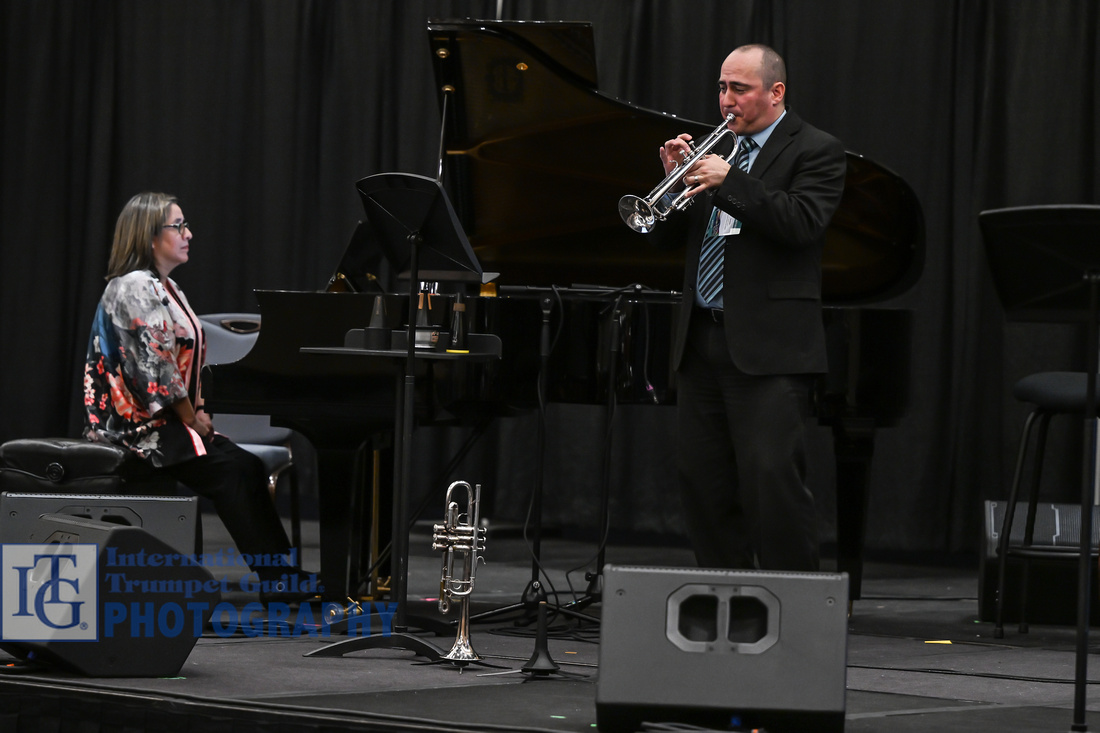

New Works Recital III
The third and final New Works Recital of the conference opened with the Southwestern Oklahoma State University trumpet ensemble performing Giovanni Gabrieli’s Canzon Septimi toni à 8 No. 1 and Eric Fregoso’s Celestial. The ensemble navigated the intricate works with gusto and confidence.
Benjamin Horne’s Buzz Buzz is a playful work for trumpet, flute, and piano. The chromatic theme, partnered with trills, was reminiscent of Flight of the Bumblebee. Performers Michael Brown and Lorin Green balanced each other perfectly, matching dynamics, style, and articulation. The humorous middle section, intended to be a “state of inebriation,” provided an enjoyable contrast to the energetic conclusion of this work.
Juan Carlos Valencia Ramos’s Parallel was performed brilliantly by John Kilgore and Rebecca Wilt. Traversing between Western European and Latin American elements, the performers provided an emotional and heartfelt rendition of this work. Scoops, pitch bends, and flutter-tonguing enhanced Kilgore’s musical statements, but he surprised the audience with foot stomps and even screaming. Overall, the rhythmic intricacies and dance-like melodies created a wonderful, enjoyable piece for the trumpet repertoire.
Hope Salmonson’s Salutation Over Fractal Ground is a programmatic work depicting how light reflects off a snowy landscape: first the moonlight, causing a crystalline glimmer, and then the sunrise, glowing warmly and painting the snow with beautiful pastels. Christopher Keach portrayed the meditative opening brilliantly with a soothing tone, creating seamless timbre transitions between the trumpet and piano. The upbeat second section was displayed eloquently, depicting the imagery intended by the composer.
Francis Snyder’s Sharps, Flats, & Orange Cats depicted the personality and various moods of a rotund cat. The four short movements “Ham Time,” “Sunspot,” “Through the Window,” and “Zoomies” created an enjoyable and light-hearted work. The usage of different mutes to create timbre changes and the ever-changing tonalities of the third movement were intriguing. Angela King presented a convincing performance as she navigated through various styles and the pointillistic melody of the final movement.
Trenton Rhodes’ Solitude showcases the “Tristan chord” to signify a dreamy ignorance and represent questions going through the composer’s mind, such as “What is going on?” “Why is this happening?” and “Will it ever be ok again?” Ross Alhorn’s sweet tone accompanied by the lush harmonies of the piano portrayed this atmosphere. The middle section of this piece transported the listener through a plethora of emotions from jealousy to joy. Alhorn’s crisp articulations and impressive power helped drive toward the climax before the piece concluded in a similar fashion to the start.
Linas Rupšlaukis performed his own composition, The Gambler, which won the Lithuanian Composers Union competition in 2017. As Rupšlaukis stated in the program notes, “Every time you perform, you gamble a little for a higher quality, a more powerful expression, or a deeper content.” Rupšlaukis flawlessly negotiated the intervallic melodies and made some of the most technically demanding passages sound easy. His artistry was on full display, and his musical risk-taking paid off in this performance.
Kenley Kristofferson’s The Stars of November is another programmatic piece that portrays the myriad of emotions felt by the parents of a baby who was diagnosed with Potter’s Syndrome while still in the womb and came into the world stillborn. The solemn introduction foreshadows the sorrow to come, but there are moments of excitement and joy intended to portray the hope of welcoming a new life into the world. Kayla Solomon and Danielle Guina delivered a powerful performance with great passion and fortitude.
The recital concluded with Jesse Cook performing the second and third movements of Imagined Conversations by Zack Stanton. Based on the idea that forms of communication and how people build relationships are rapidly changing, especially with social media, each movement is loosely based on the idea of human communication/relationships with the overall trajectory being one of hope. Feelings of unsettledness are created in the second movement by the conflicting rhythms between the flugelhorn and piano performing simultaneously. Cook captured the audience’s attention by displaying his rapid finger dexterity and strength leading to an exciting conclusion on piccolo trumpet. (Steven Siegel)
Merrie Klazek session - Trumpet Around the Sun
The trumpet quartet from the Crane School of Music kicked off this session with a stylish and accomplished prelude performance. Merrie Klazek’s “Trumpet Around the Sun” project brings together musicians from across the globe and presents listeners with the opportunity to hear the trumpet in settings that perhaps we would not expect at first. Several years in the making and involving 25 musicians from 14 different countries, the music spans 400 years, 15 countries, and 6 continents. This spectacular endeavor takes listeners on a musical journey with incredible lyricism. The theme of “Music as a Global Connector” becomes particularly poignant as we hear about Merrie’s work and processes to bring this wide-ranging project together. An important message is the unity across international borders to create wonderful storytelling through music. (John Hutchinson)
Peter Pickett session - So You Want to Go into Business?
“The Game of Life for Musicians” was a joyous, funny, and informative presentation by Peter Pickett, the owner of Pickett Brass. The session began with the selection of four volunteers who were each assigned a role for the “Game of Life,” which included a professional player, business owner, job/regular employee, and trumpet professor. Pickett emphasized that though we may have specific plans, things often change and, of course, “life happens.” Illustrations of life choices, jobs, finances, luck, job loss, taxes, medical issues, unexpected changes, cars, housing, and family were presented, and the session ended with an insightful and delightful question-and-answer session. Attendees were encouraged to plan for change and to develop the ability to adapt to “life happening” in order to be successful and ultimately leave a legacy greater than ourselves. (Lacey Phelps)
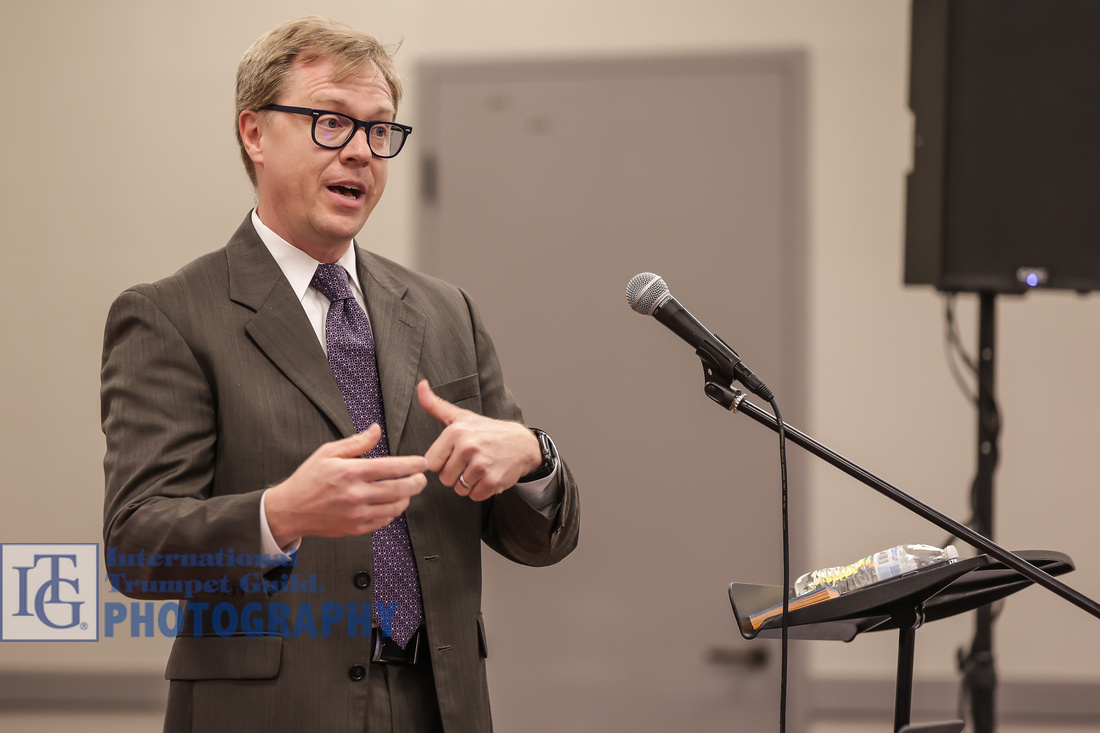

Ryan Anthony Memorial Trumpet Competition: Chamber Music Division Finals
Among the sixteen groups that applied to the thirteen semifinalists, the final round consisted of four ensembles that all performed at an exceptionally high level. Each ensemble was allotted ten minutes to perform whatever musical selections they wanted, and this resulted in a beautifully contrasting program. First to compete was a trumpet sextet from Escola Superior de Musica a Artes do and they performed Jorge Salgueiero’s Fanfare Festivo. This colorful and expressive work showcased a homogeneous sound across the ensemble. Their second selection, Erik Morales’s Conquest, demonstrated the commanding and exciting character of the ensemble. Lux Brass from Baylor University prepared three selections for their portion of the competition. From the exciting and pristine opening of the Malcom Arnold Quintet, to the tenderness of “Somewhere” from West Side Story, and ending with the intense and intricate Mini Overture by Lutoslawski, Lux Brass showcased a wide range of musical maturity. The Michigan State University Trumpet Ensemble brought new life to well-known and demanding French etudes in their performance of Bitsch’s Brew by Connor Johnson. The familiar melodies were executed at a high level and were interwoven with original material that complemented the source material. The final competitor was the UCLA Trumpet Ensemble, performing Dimitri Shostakovich’s String Quartet No. 8, arranged for six trumpets. The eerie, yet beautiful, character of the opening was complemented by the fiery passion of the latter half of the quartet. (Will Koehler)
Clément Saunier recital - French and Contemporary Trumpet Repertoire
Following the well balanced, highly energetic, and very exciting prelude performance by the Duquesne Trumpet Ensemble, under the direction of Dr. Chris Wilson, of Tony Plog’s Contrast for Five Trumpets, French trumpeter Clément Saunier presented a robust program of French and contemporary musical works for trumpet. The pieces included on Saunier’s recital are considered some of the most challenging in the trumpet solo repertoire–those by Jolivet, Tomasi, Gaubert, Berio, Henze, and Erikson. Throughout the recital, Saunier and his collaborative pianist, Maria Rutkowska, displayed an incredibly impressive level of musicianship and virtuosity. Saunier’s sound was clear and resonated throughout the Westminster Church sanctuary. The audience was enthralled by the performance and showed their appreciation by giving an extended standing ovation. (Javian Brabham)
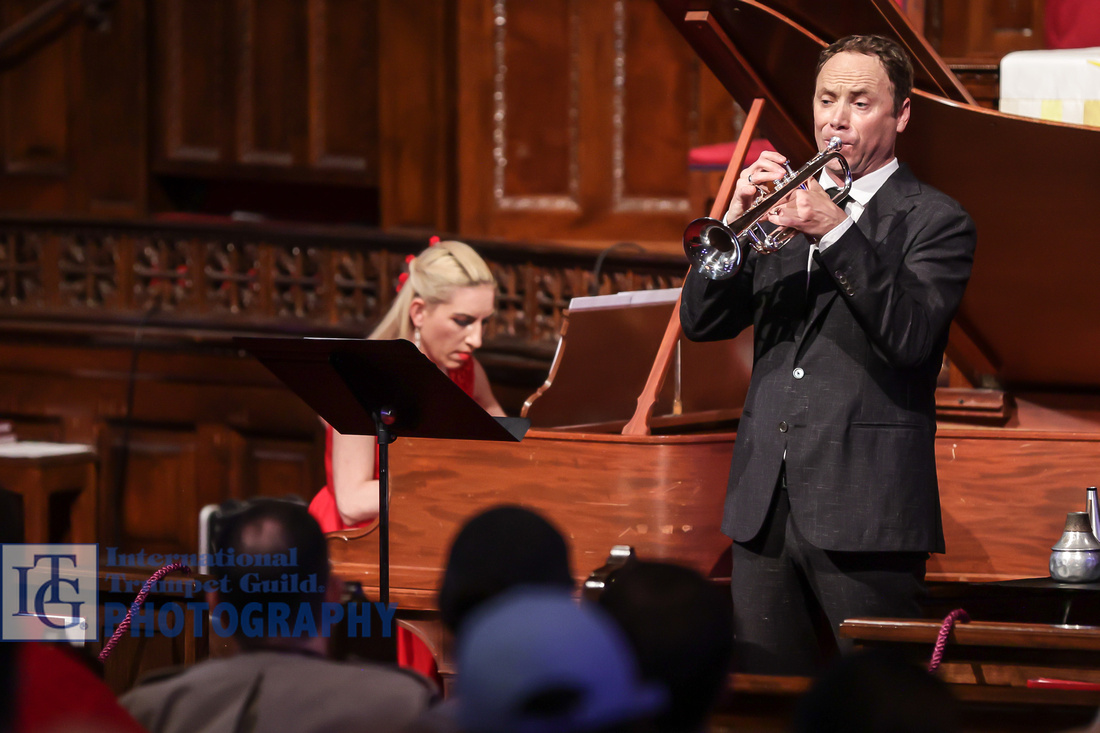

Jean Laurenz session - DESCENDED: A Multidisciplinary Exploration of Music, Film, and Narrative
In this session, Jean Laurenz presented her film Descended and answered questions regarding the creative process of the making of the work. The film is an abstract ghost story based on the life and work of Lafcadio Hearn, a nineteenth-century writer and cultural preservationist. In the film, the trumpet represents the spirit of the next stage of the main character’s life, and the voice is representative of the female presences in Hearn’s life. There are many calls to symbols in Hearn's writing and Japanese texts throughout the film, such as the use of mirrors, eyes, water, and shadows. This striking work has won numerous film festival awards and showcases Laurenz’s multifaceted artistic endeavors. (Nathalie Crissela Mejia)
Michael Sachs session - Preparation and Performance of Standard Orchestral Repertoire
The Albuquerque Trumpet Quartet from the University of New Mexico played an exciting arrangement of Johann Sebastian Bach’s Little Fugue in G Minor and Beatrix Cordona’s beautiful Dos Tiempos to open the session. Michael Sachs, who has held the principal trumpet position with the Cleveland Orchestra for 35 years, then discussed his thoughts on excerpts and the various ways that he approaches trumpet playing in an orchestra through excerpts from Pictures at an Exhibition, Petrouchka, Concerto for Orchestra, and Leonore Overture No. 2. In Pictures, Sachs finds the intervallic relationships between all the notes. His goal is to match the shape of each note from beginning to end. When practicing Petrouchka, Sachs creates sequences resolving the downbeats of each beat to find consistency in sound and style within a simple outline of the excerpt. Within the Bartok, Sachs stays true to the articulations and dynamics, stating that the muted section needs to have a “nasal sound” to truly capture the style of the piece.
Some of Sachs’s most important suggestions were the following:
- Sound is the most important element in winning an audition.
- Make a plan!
- Find recordings of great players and begin to learn the dynamic and rhythmic contrasts.
- Understand your role within the piece, the intonation tendencies within the orchestra, the style of the piece, the articulation that is right for the acoustical environment, and the color used within the piece in order to truly understand it.
(Angela King)
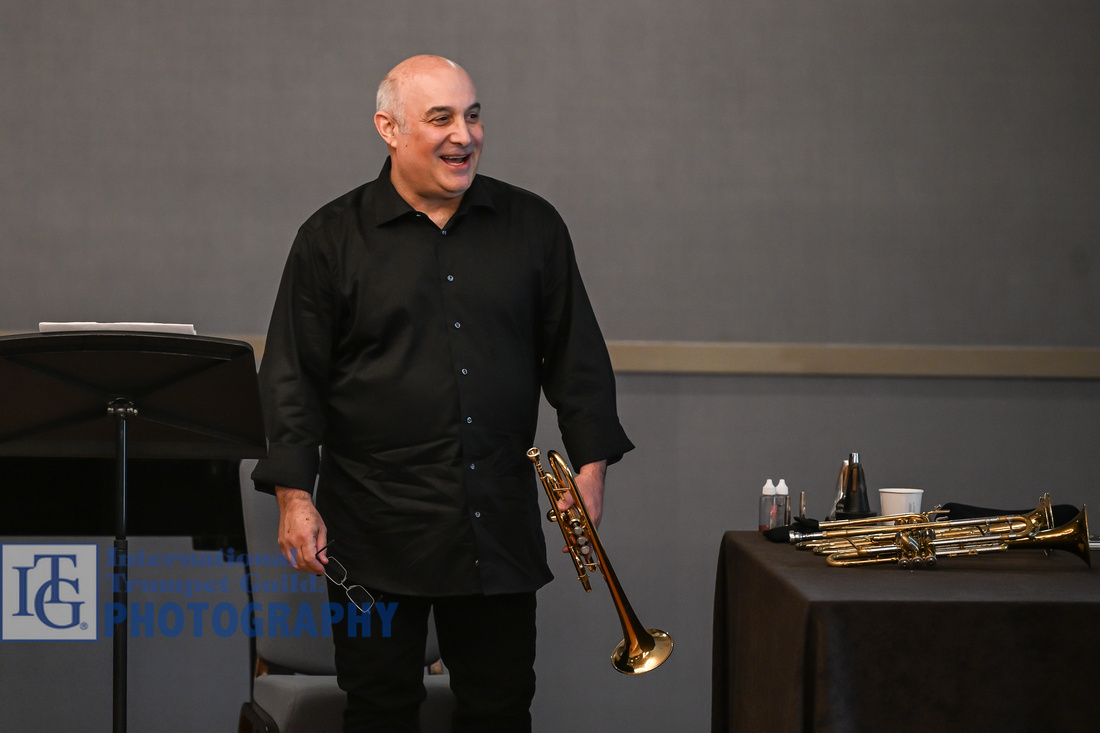

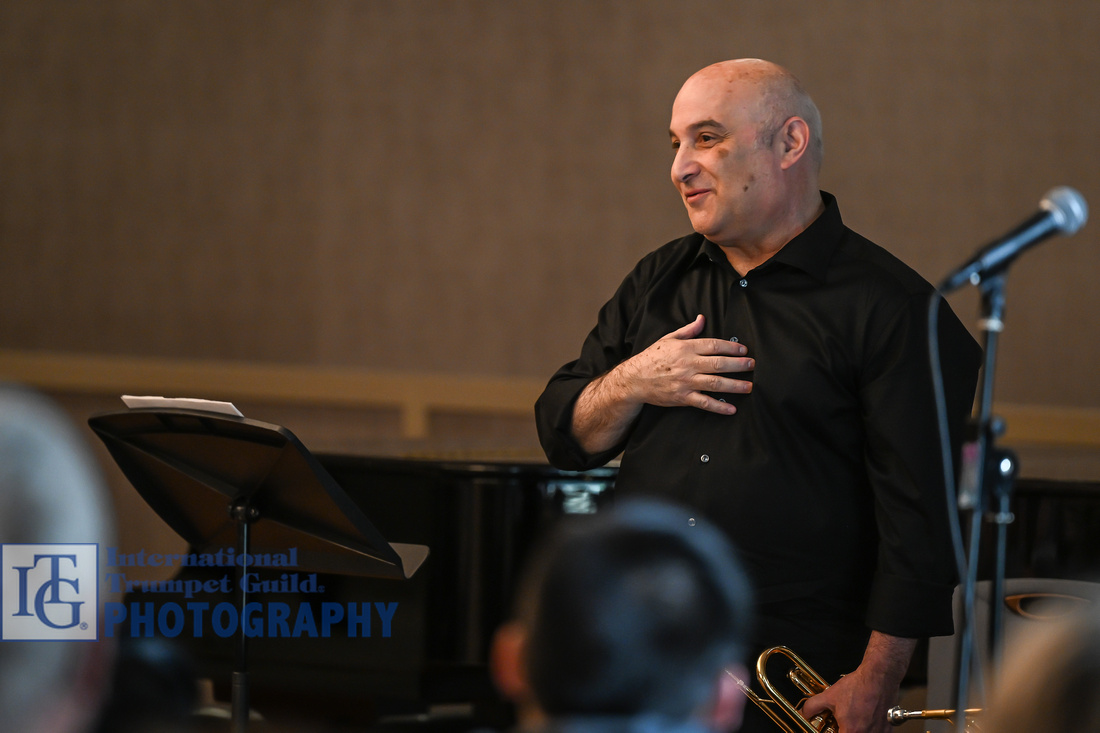

Evening Concert - The Steve Wright Big Band with David Pastor, Micah Bell, Nadje Noordhuis, and Bijon Watson
This highly anticipated concert by the Steve Wright Big Band and a stellar lineup of guest soloists was preceded by a prelude by the Colorado State University Trumpet Ensemble, performed with immense skill and flair. The show openers came at the hands of the splendid Spaniard David Pastor, with vibrancy and energy by the bucket load, as well as some emotional lyricism. Micah Bell was up next with his incredible intensity of tone across soaring melodies, followed by Nadje Noordhuis leading the band in a more contemplative mood on both trumpet and flugelhorn. Her deeply reflective and soulful style transformed the room to create an electric atmosphere. The powerhouse that is Bijon Watson completed this superstar roster with scintillating sound and high energy, contrasted by some sultry and intense flugelhorn playing. This was an incredible night for the ITG crowd! (John Hutchinson)
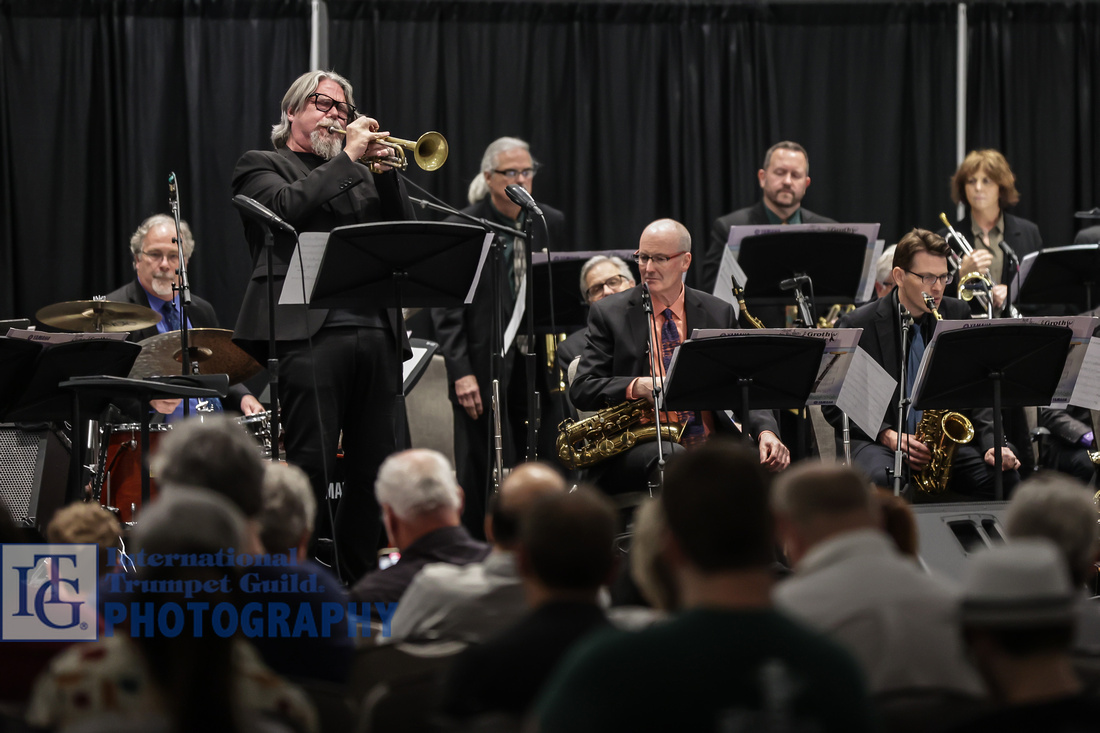

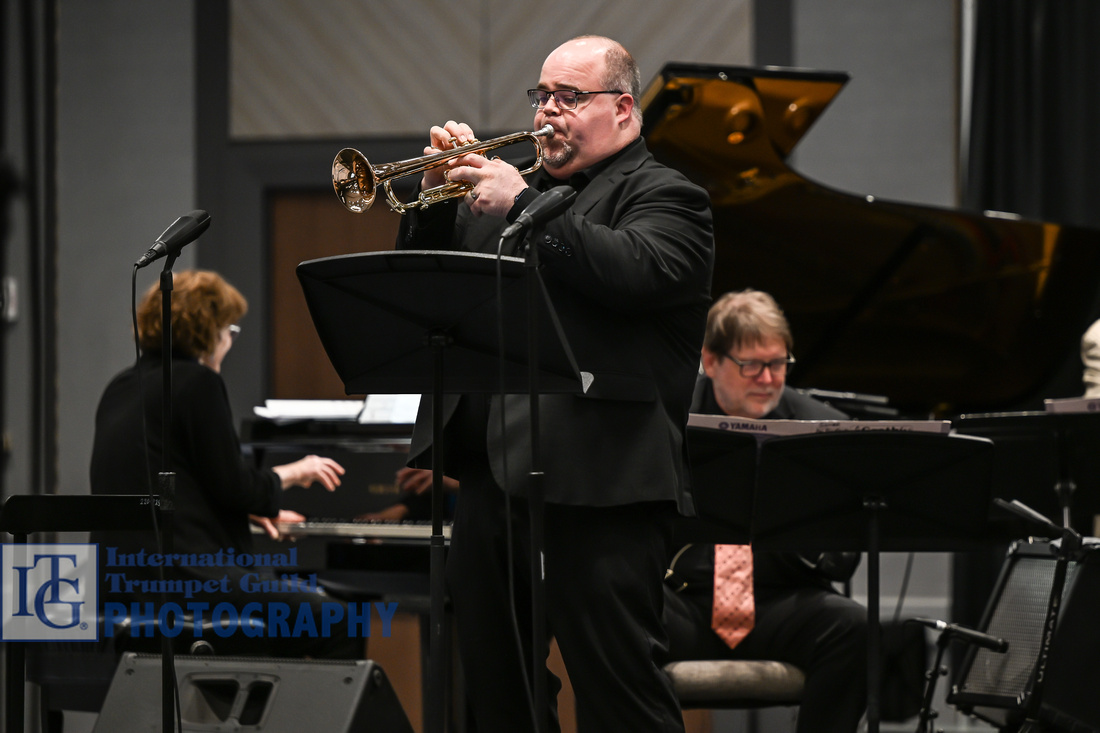

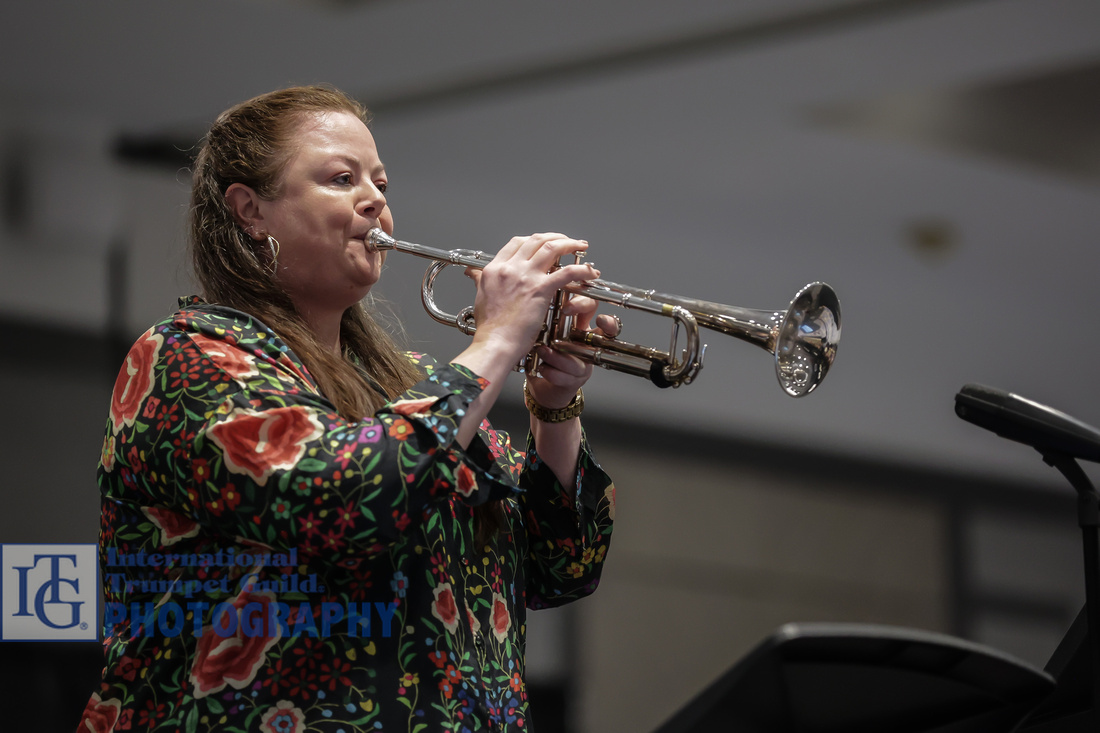

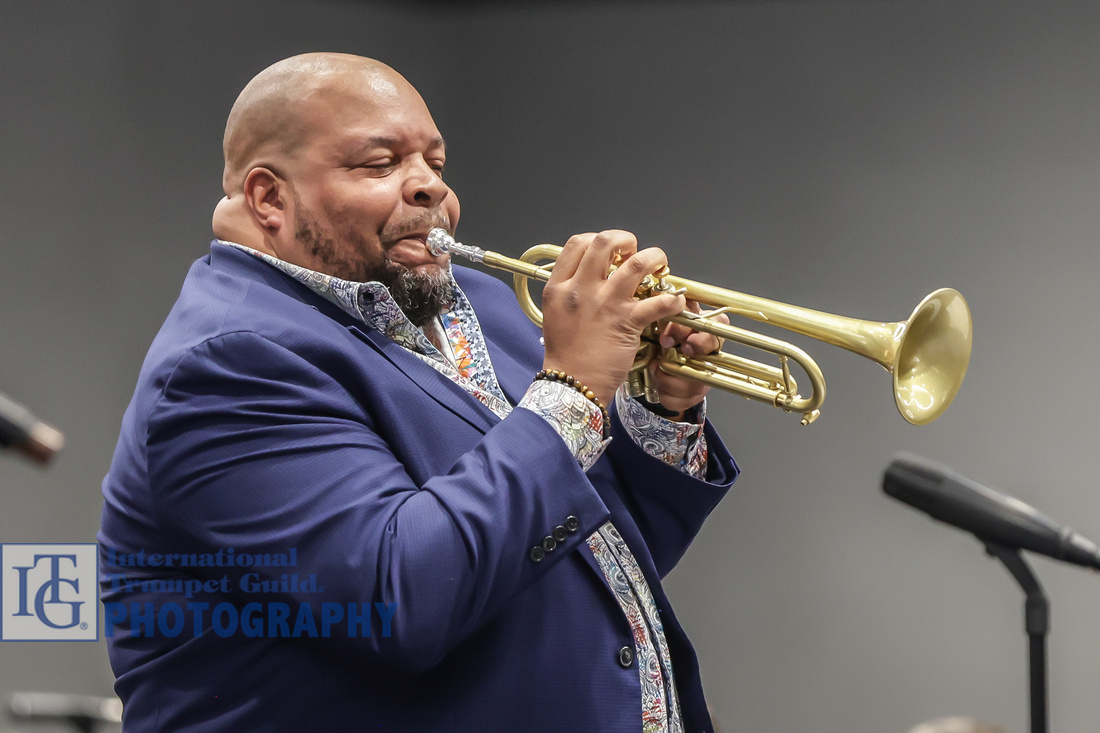

Concert - John Swana and Jean Laurenz
A delightful rendition of Poet and Peasant was presented by The Wells School of Music Trumpet Ensemble to open the evening concert. The Conference Jazz Trio was then joined by Philadelphia-based trumpeter John Swana and the trumpet professor from the University of Wisconsin-Madison, Jean Laurenz, to present a concert with an eclectic mix of styles with tunes by Kenny Dorham, Kenny Wheeler, Miles Davis, Jean Laurenz, Thad Jones, Frederic Chopin, and Clifford Brown. Unique was Laurenz’s highly attractive mash-up of music by Ravel and Radiohead, which involved both singing and Laurenz’s lush flugelhorn playing. Swana also played the EWI (Electronic Wind Instrument), which he has incorporated into his performing and composing throughout his career. He used the EWI with a synthesizer and pedals, allowing him to access a multitude of colors and effects. From jazz standards to original compositions, both artists conveyed brilliant ideas that the audience enjoyed thoroughly. (Will Koehler)
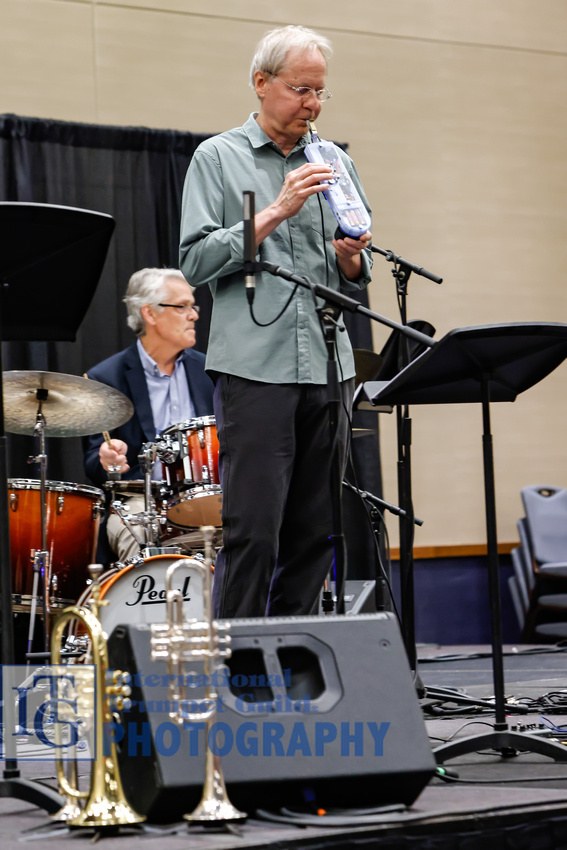

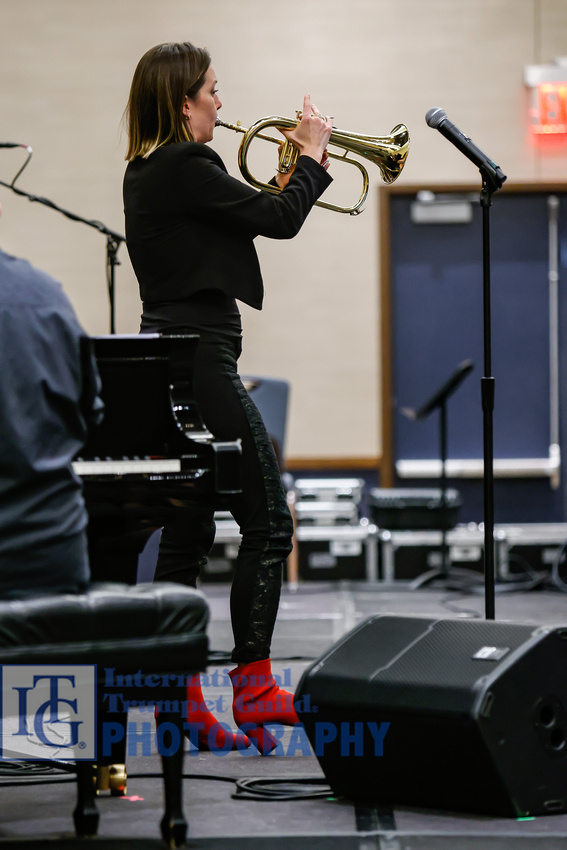

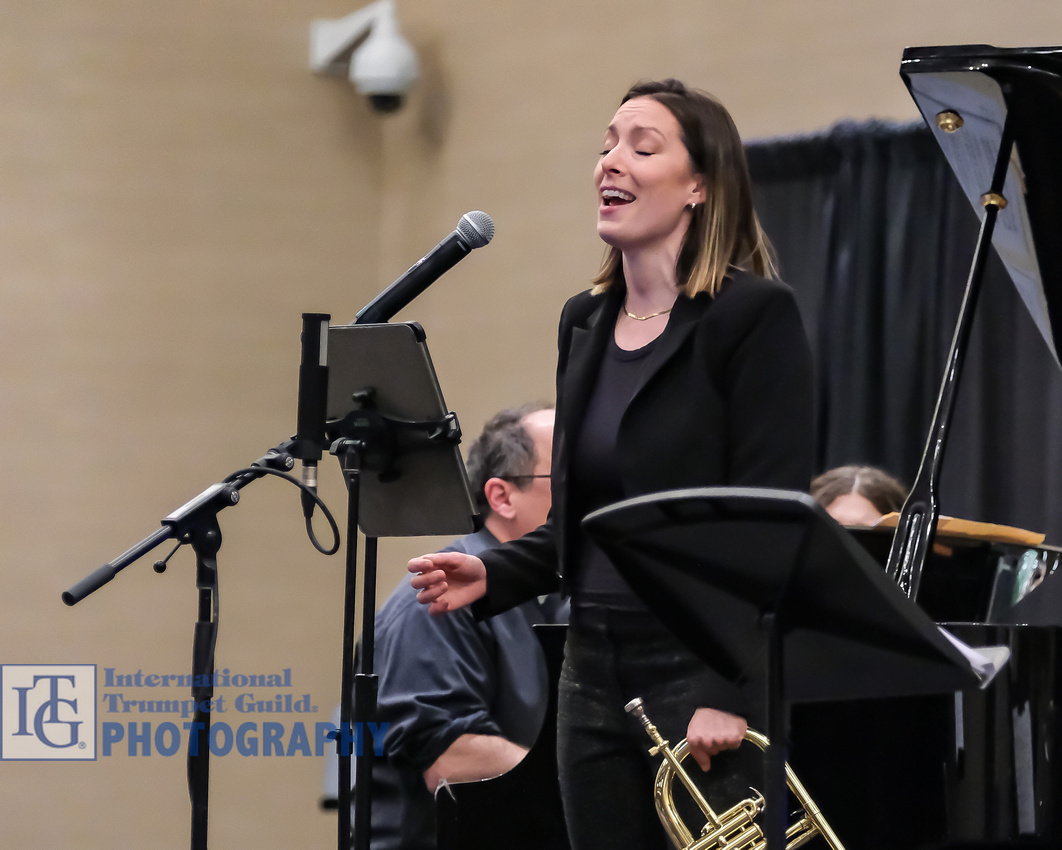

Open Jam Session - John Raymond
John Raymond led a fantastic jam session with well over fifty people in attendance late Friday night. The opening tune, I Hear a Rhapsody, highlighted Raymond’s versatility and individual style alongside the guest artists performing in the combo. After a brief, kind, and informal introduction, Raymond invited players up to join him on stage for what he called a mini-jam session, which started with You Stepped Out of a Dream. Other tunes included It Could Happen to You, On The Sunny Side of the Street, and Birdlike. Each soloist demonstrated a respectful and a professional demeanor on stage as they took turns playing with the combo throughout the session. Raymond interjected marvelous instruction and coaching in between tunes to aid in perfecting the attendees’ craft. The overall groove of the session created an ideal and relaxed ending to the day. (Lacey Phelps)
Click here for more photos from the ITG Conference